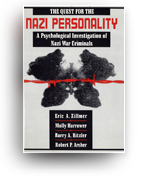 |

Open to Interpretation…The Art and Science of Inkblots
Ashland, OH: Hogrefe, 2009
[more]
............................................
Principles of Neuropsychology
Belmont, CA: Wadsworth, 2008
[more]
............................................
Military Psychology: Clinical and Operational Applications
New York, NY: Guilford, 2006
[more]
............................................
The Quest for
the Nazi Personality
Hillsdale, NJ: Lawrence Erlbaum Associates, 1995
............................................
Neuropsychological Assessment and Intervention
Springfield, IL: Charles Thomas, 1992
[more]
|
 |
|
 |
 |
 |
THE QUEST FOR THE NAZI PERSONALITY:
A Psychological Investigation of Nazi War Criminals

Eric A. Zillmer, Molly Harrower, Barry A. Ritzler, & Robert P. Archer
Hillsdale, NJ: Lawrence Erlbaum Associates, 1995
|

What are the advantages and disadvantages to sticking to the same blots?
The advantage of sticking to the same inkblots is that you can generate norms. Typically, respondents will give over 20 responses to the 10 cards and those responses can be compared to thousands of responses from normal and different psychiatric groups. The disadvantage is that they are relatively expensive, about $100. There's only one publishing house that owns the copyright. So the psychological community ended up with ten inkblots, five of them are in color and five in black and white. Through the printing process shading was introduced, which Rorschach did not initially think of. But he didn't ask for a refund. He just said, "This is interesting, let me try see if shading can contribute to some of the responses." The shading gives more of a depth to the inkblots, and possibly even three-dimensionality.
Next Question...
|
|